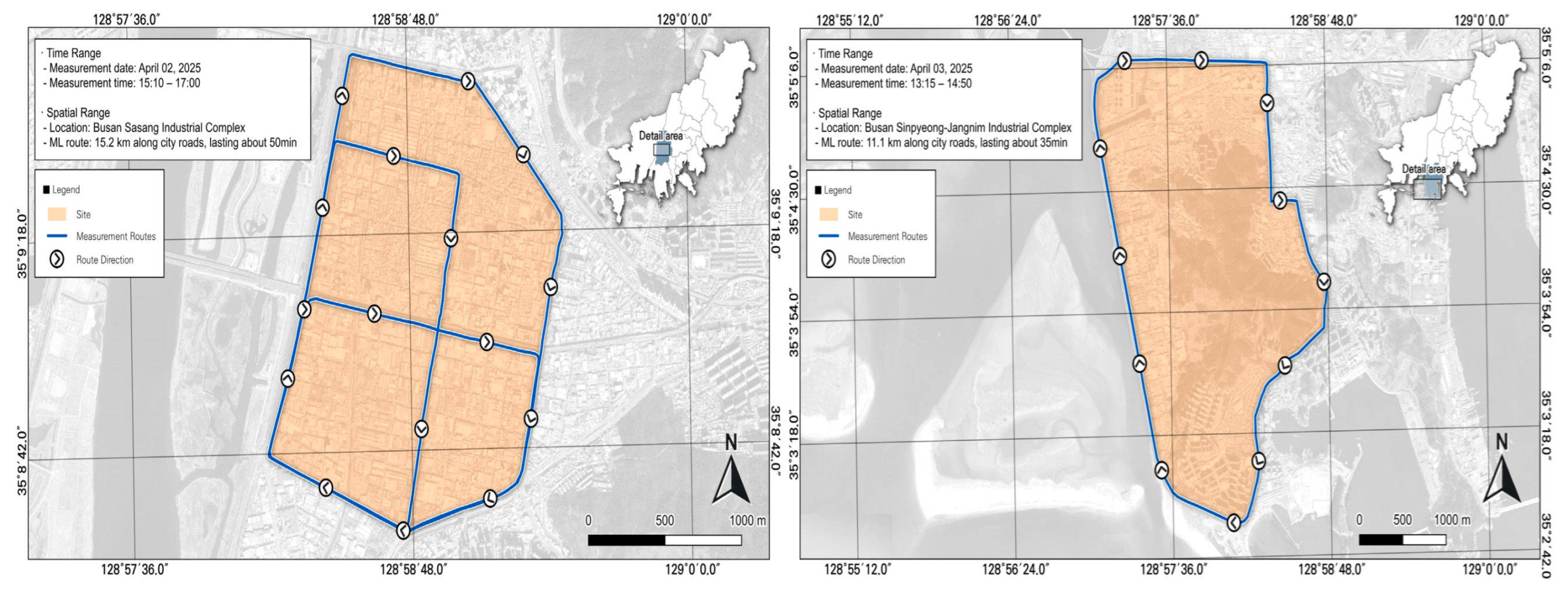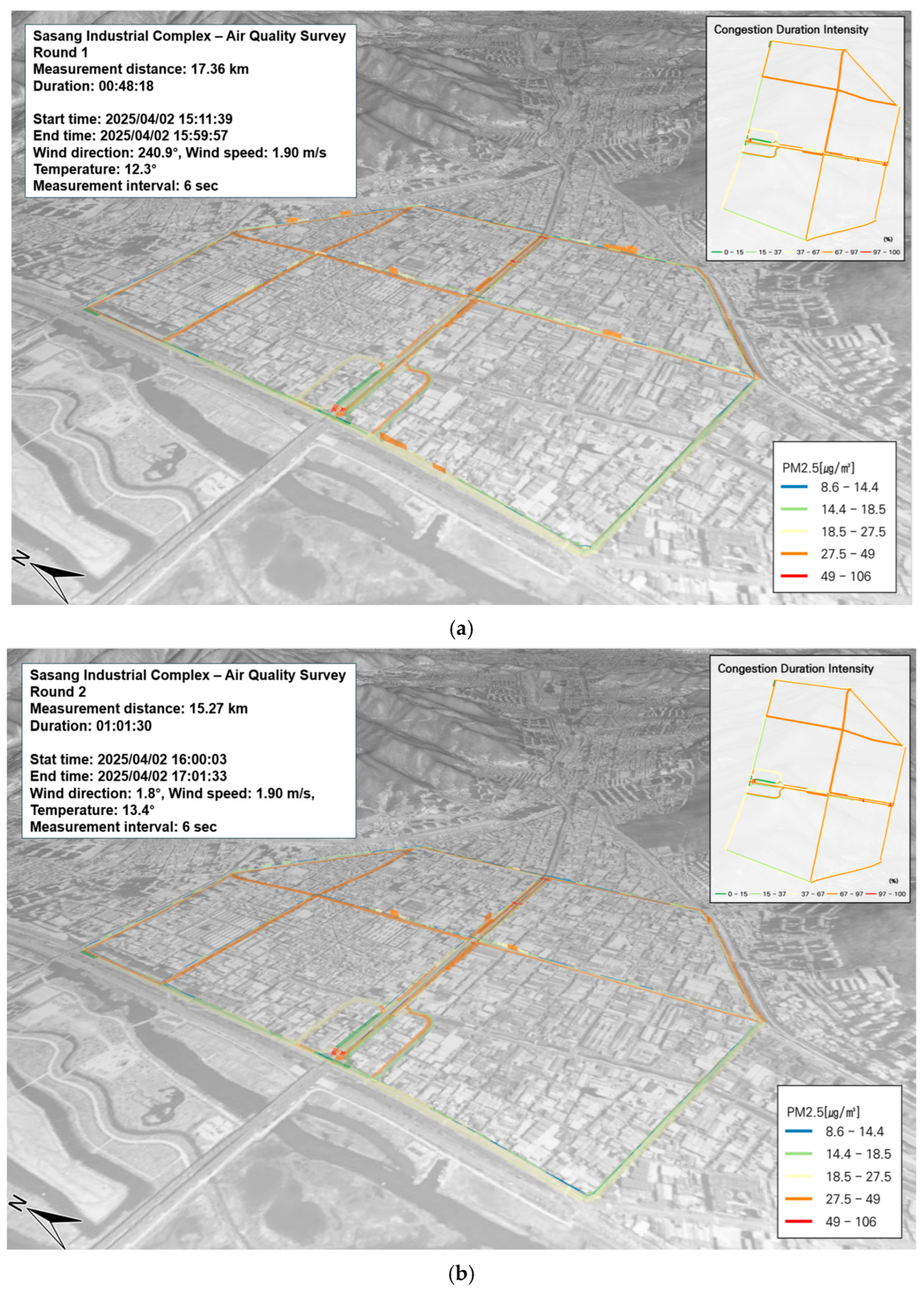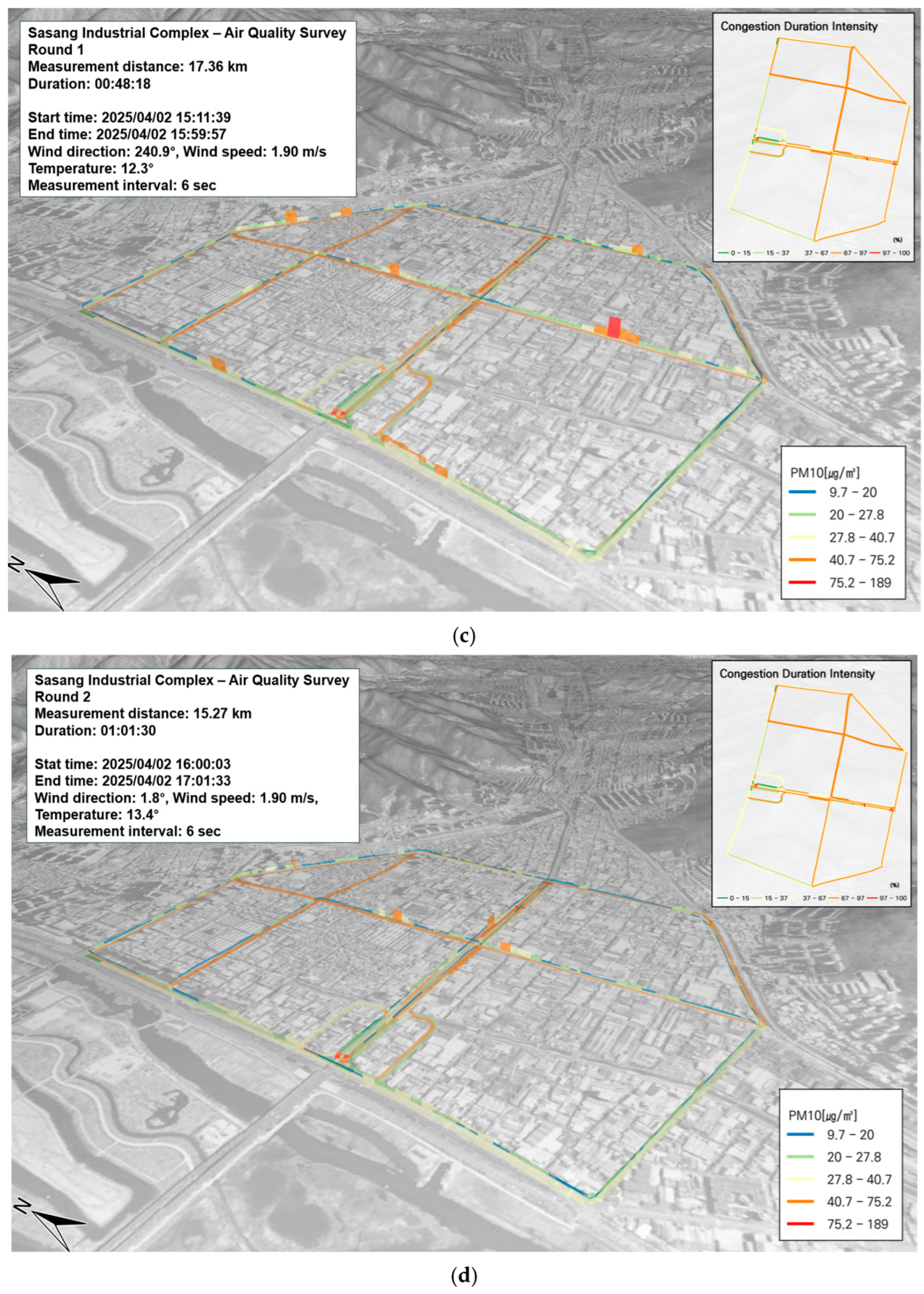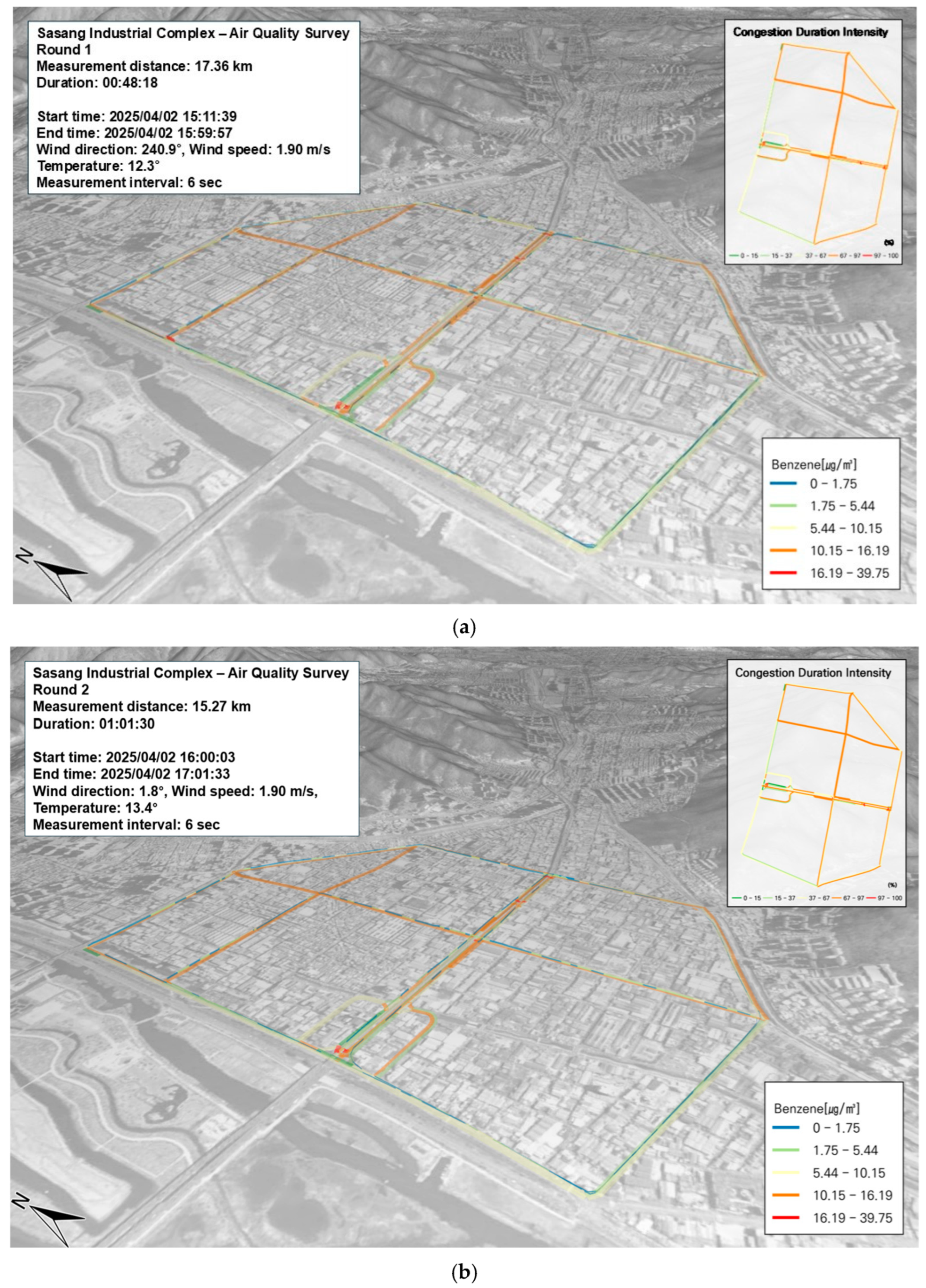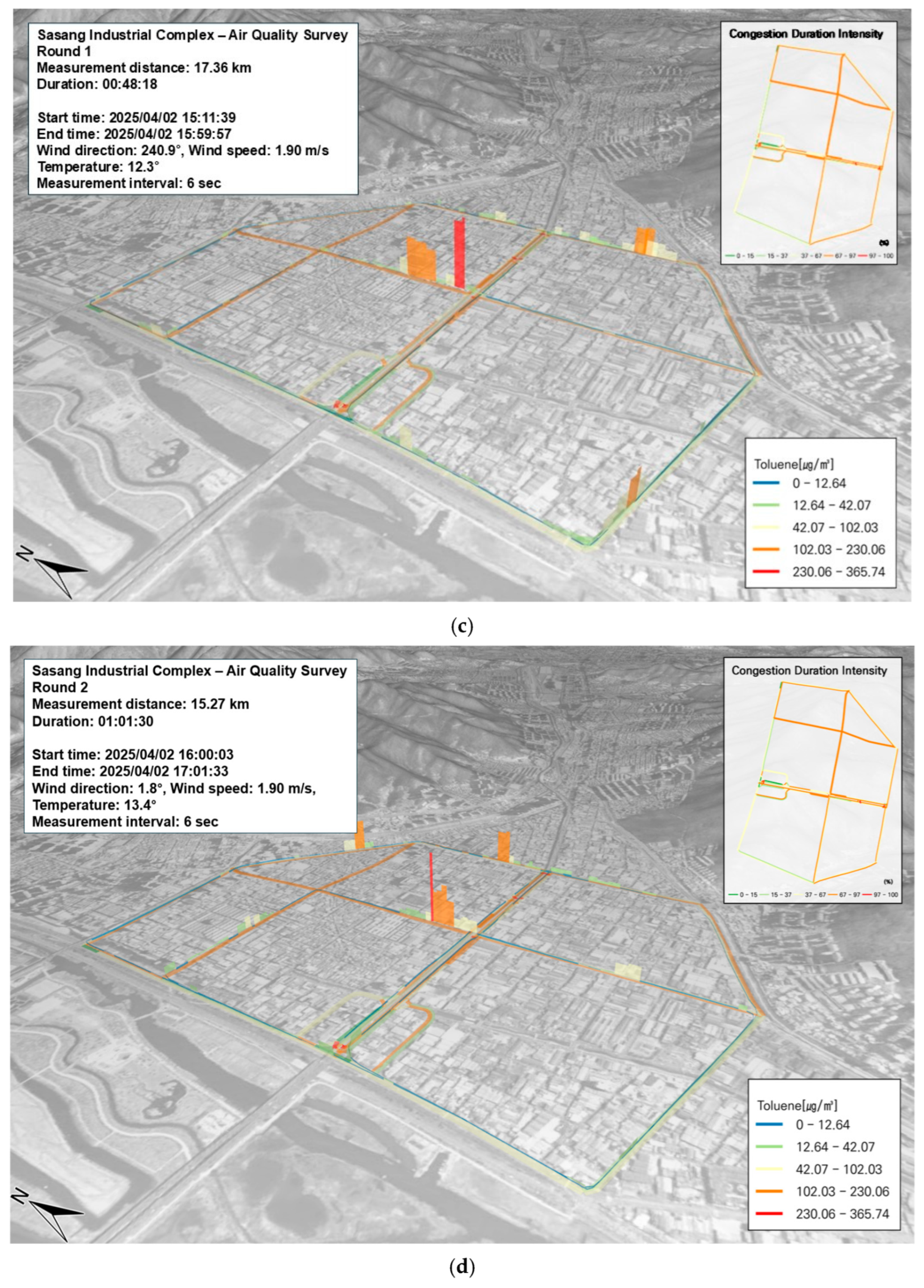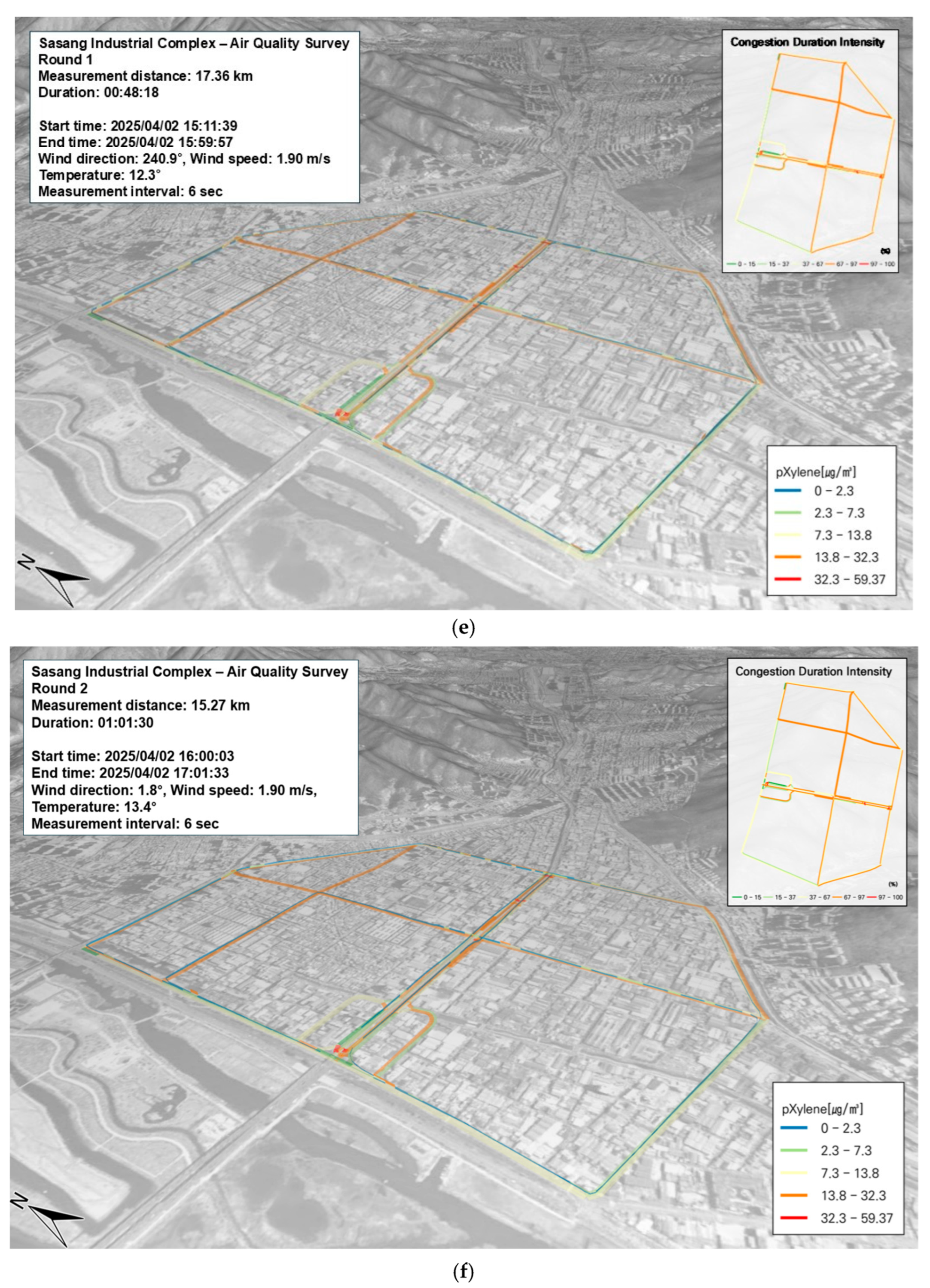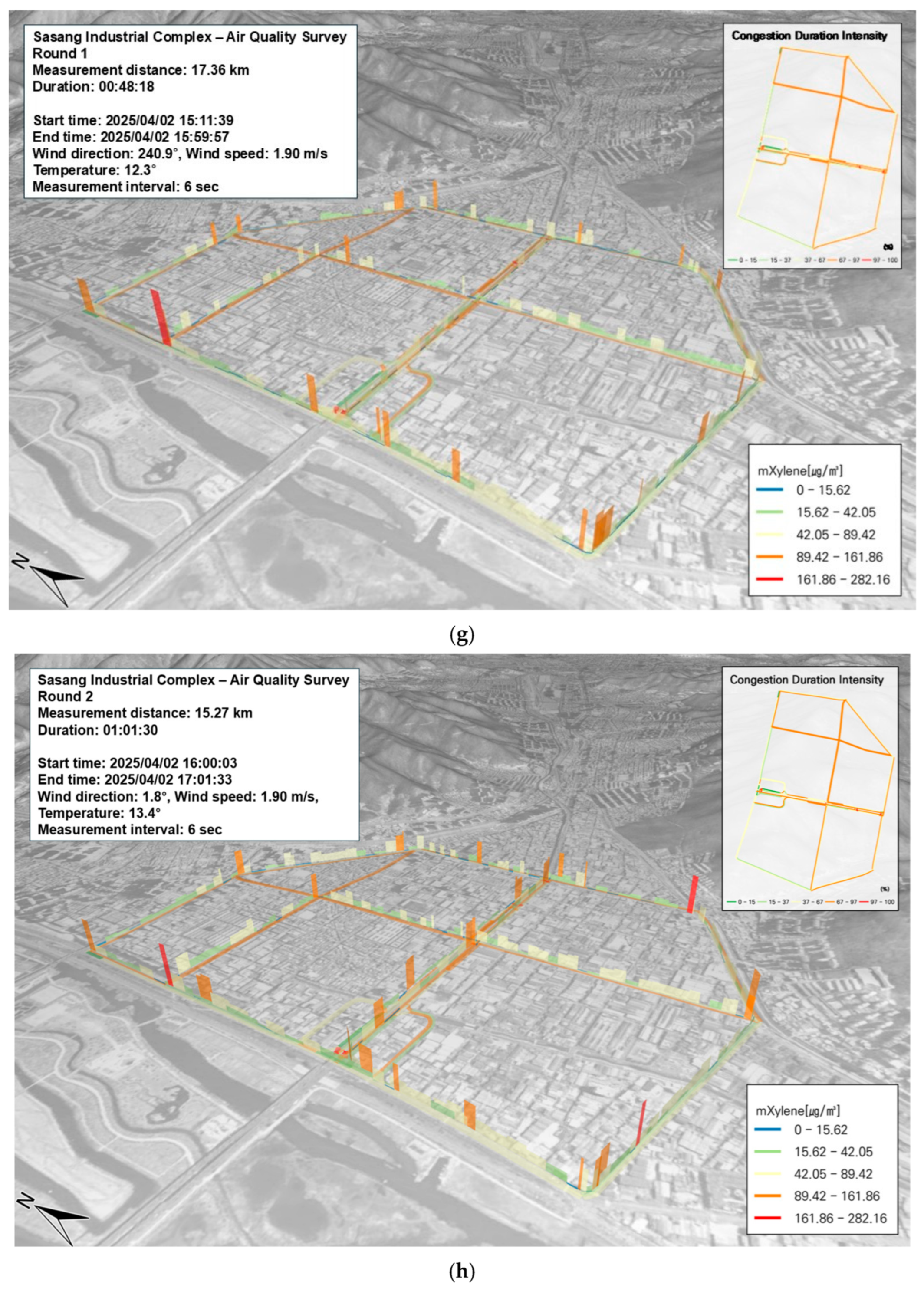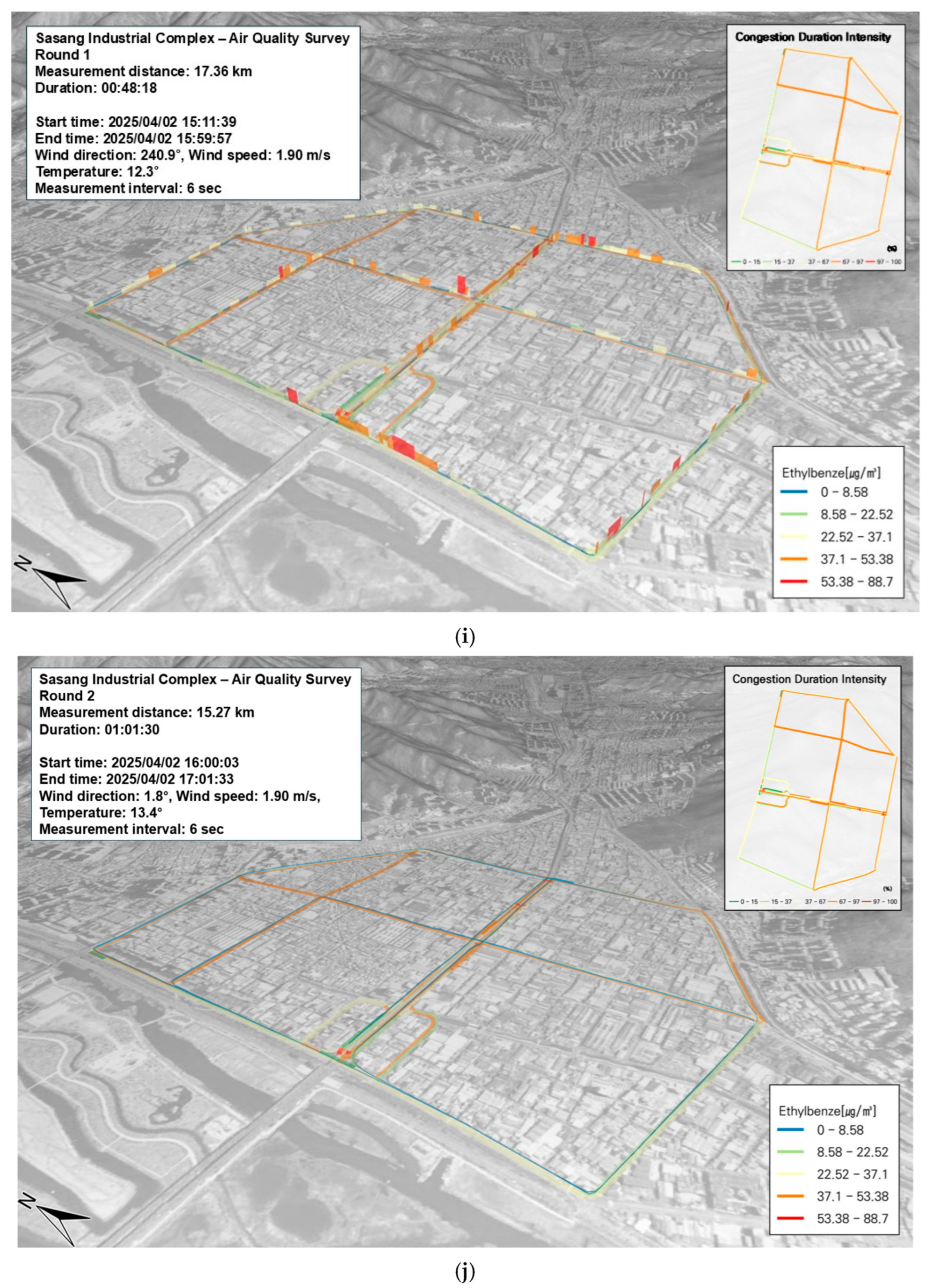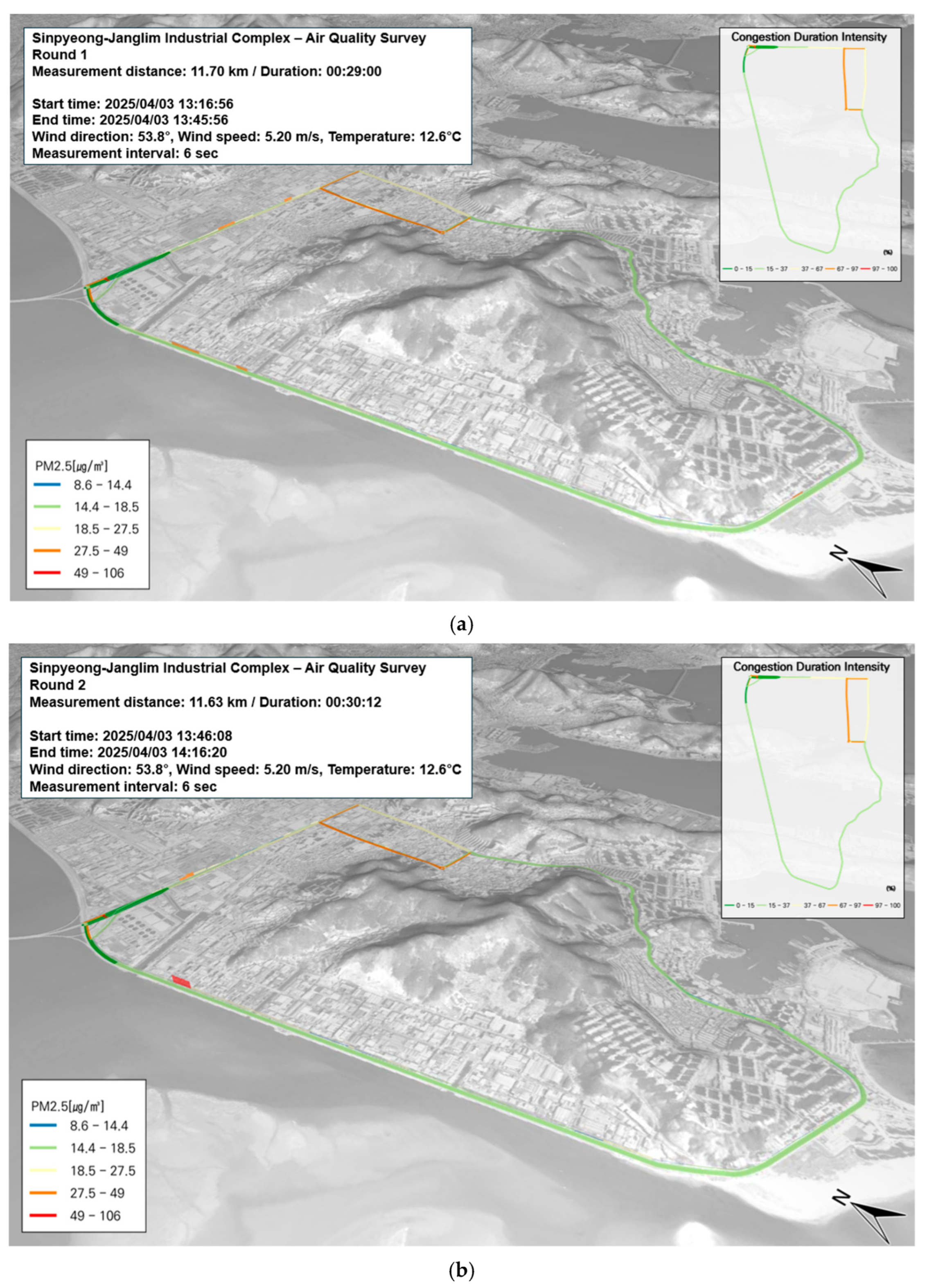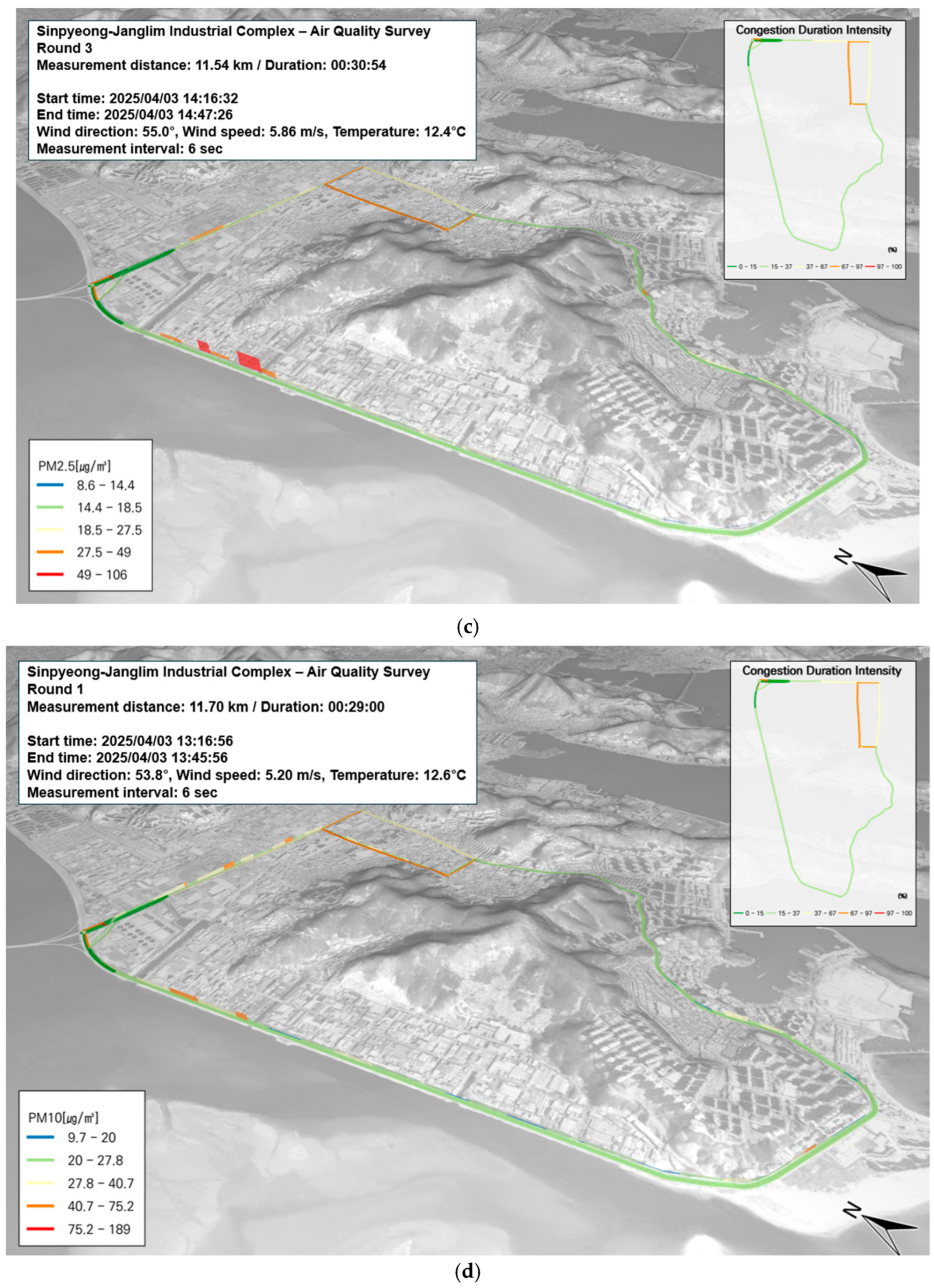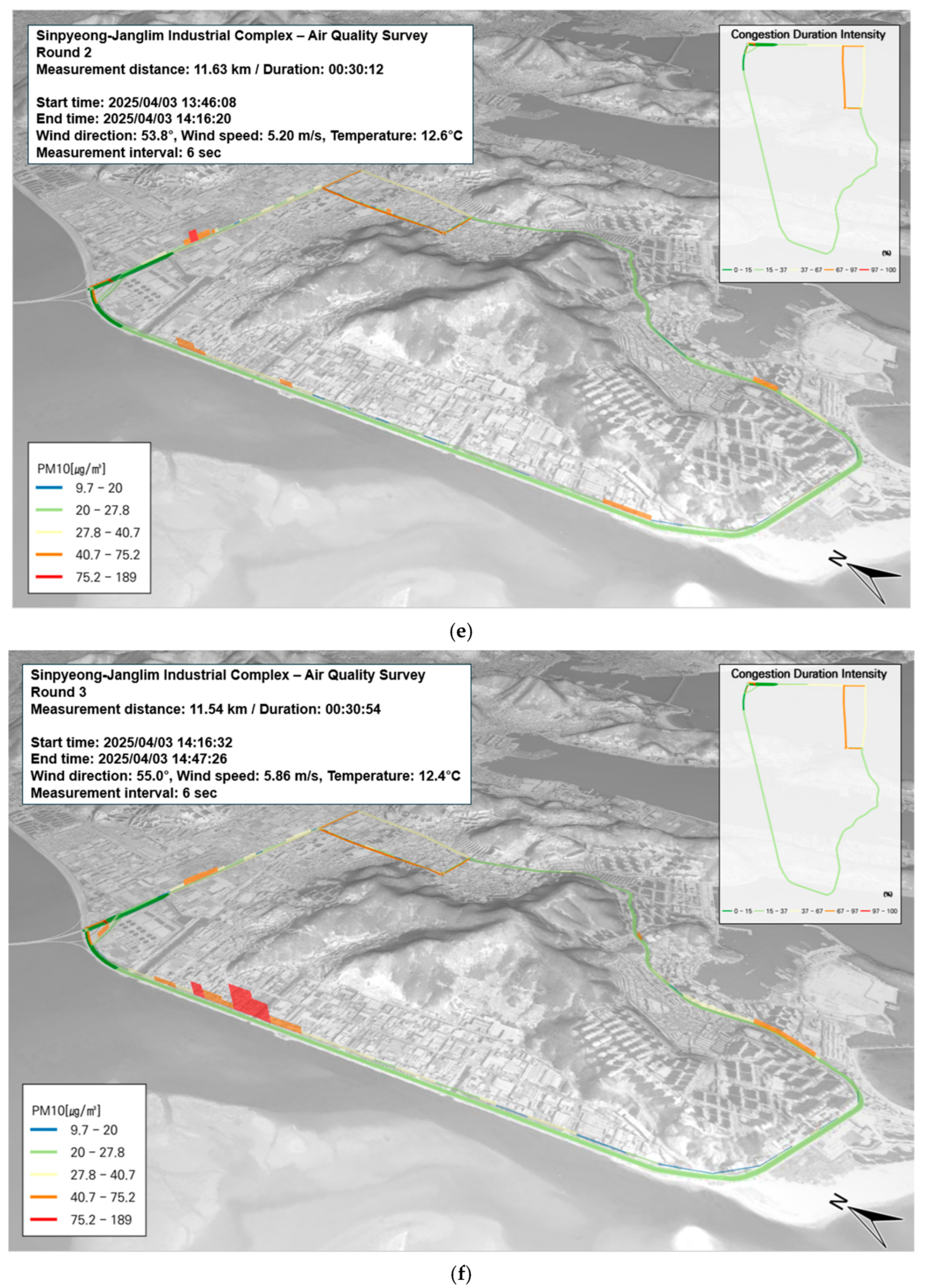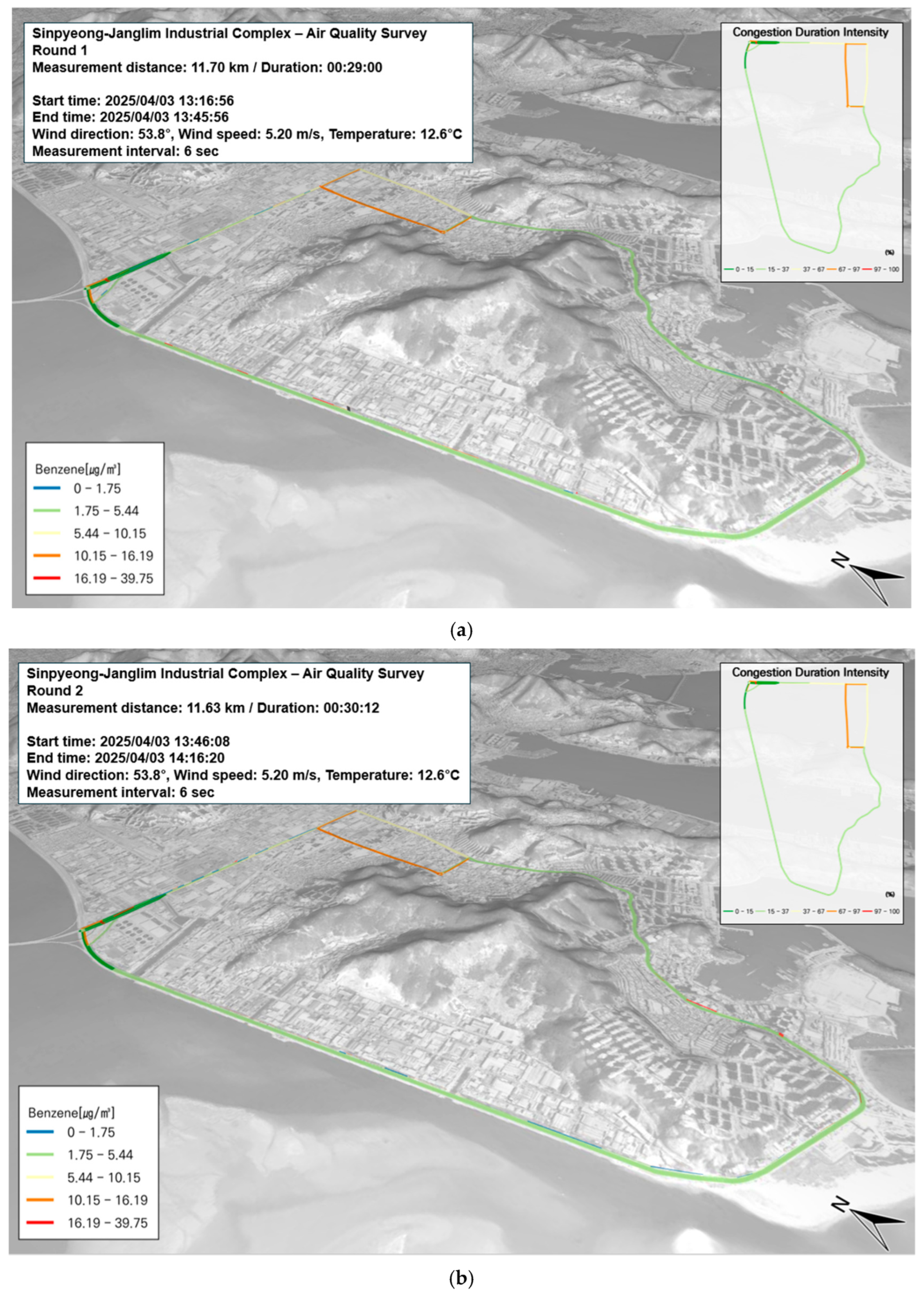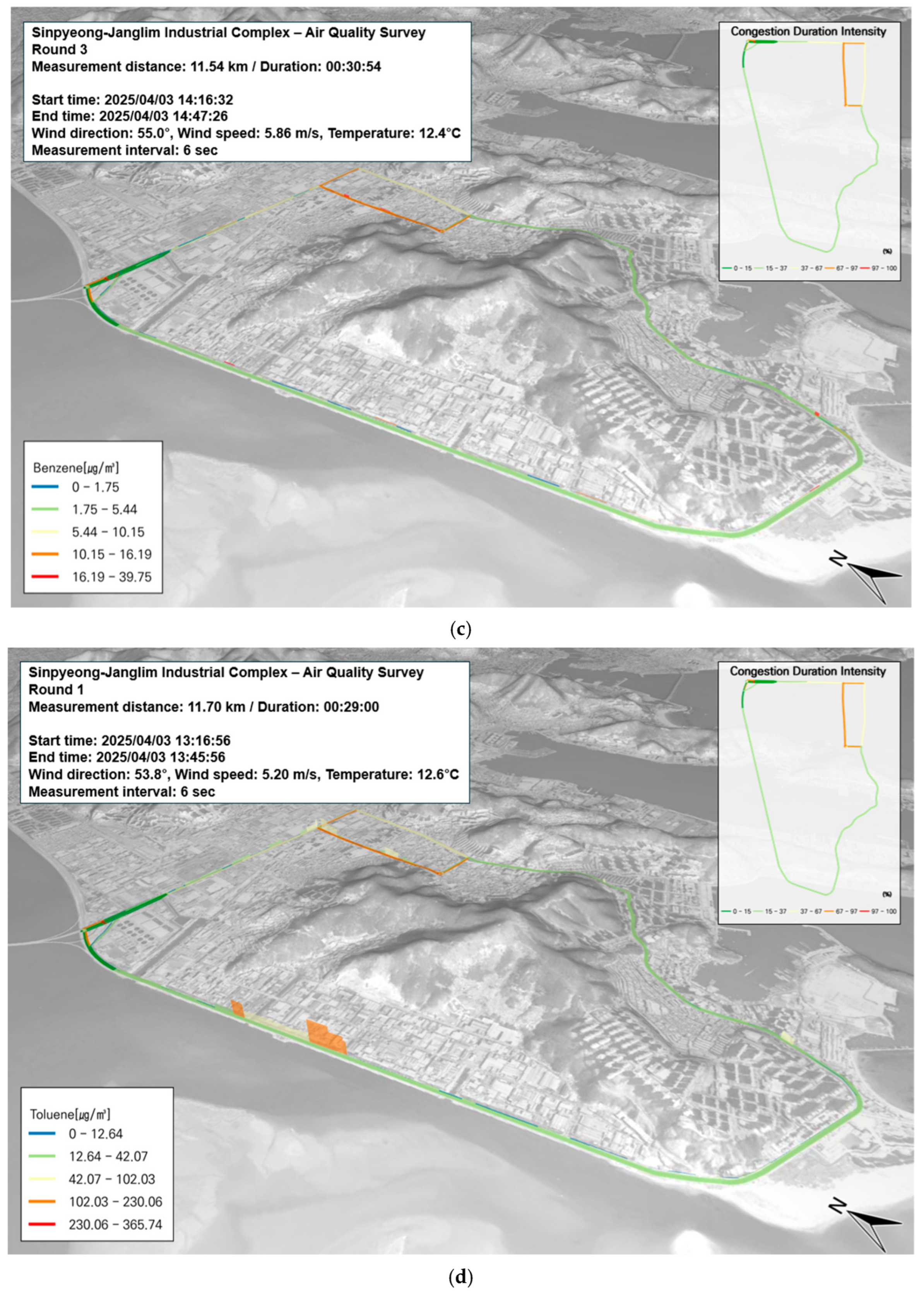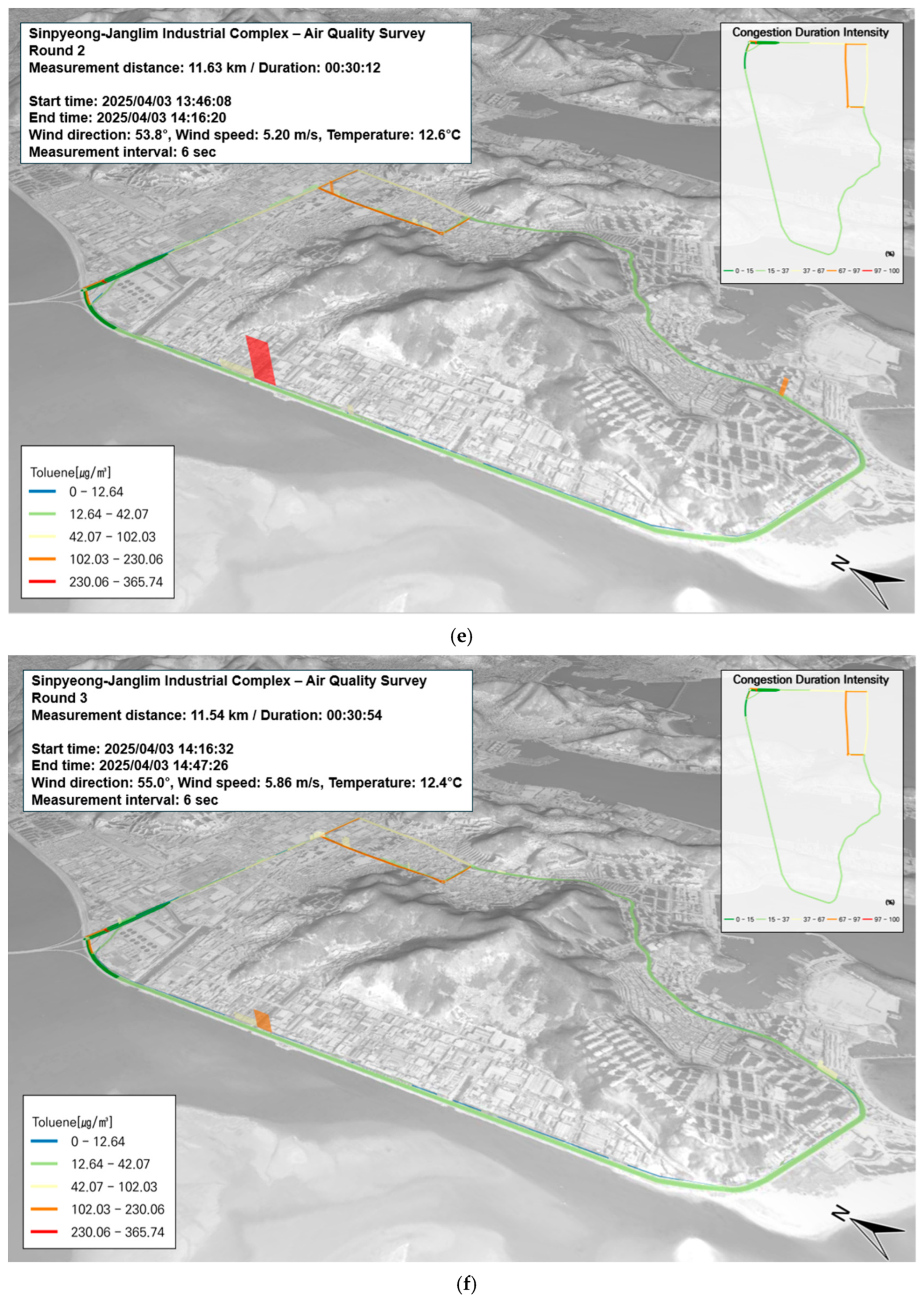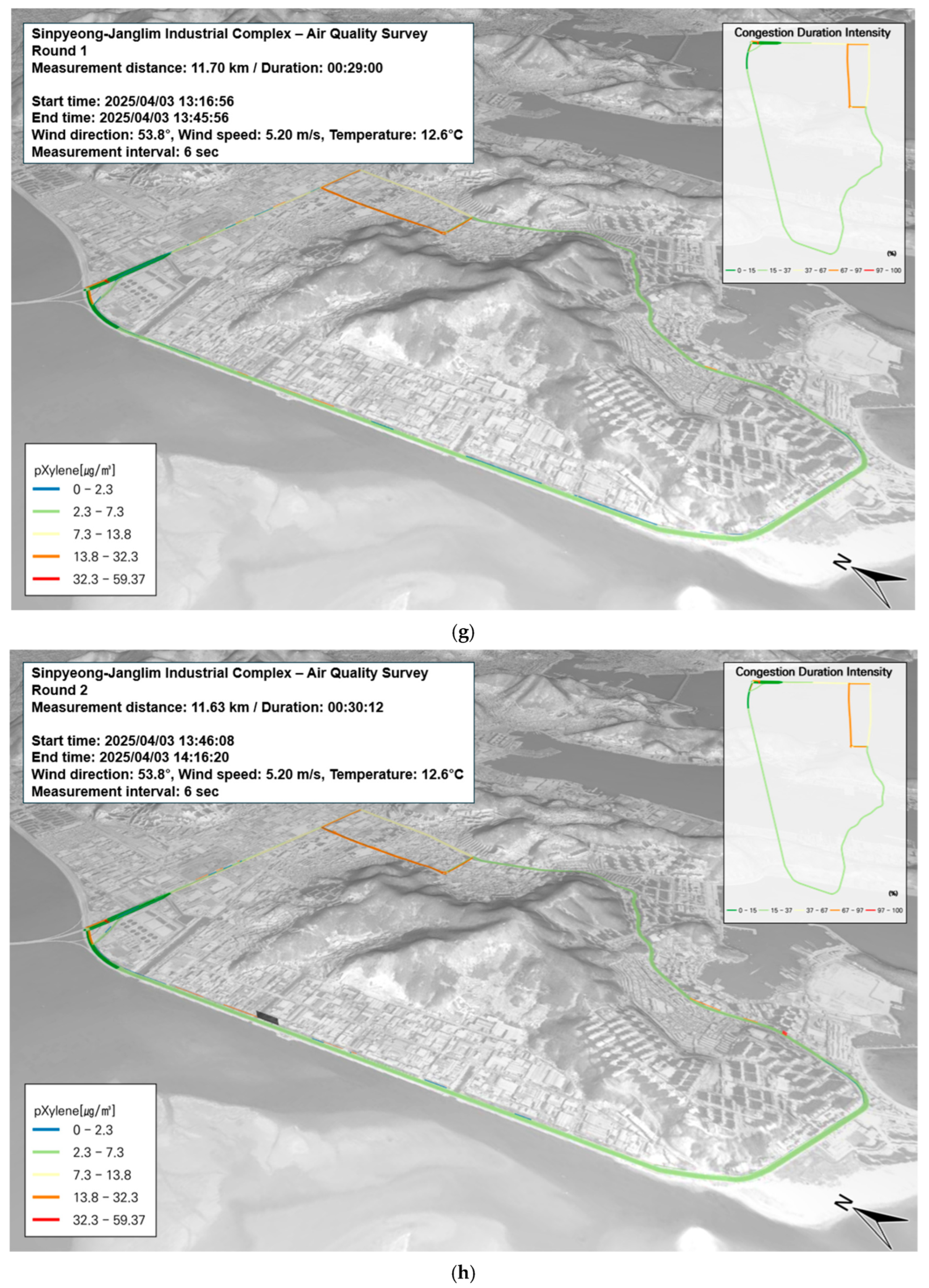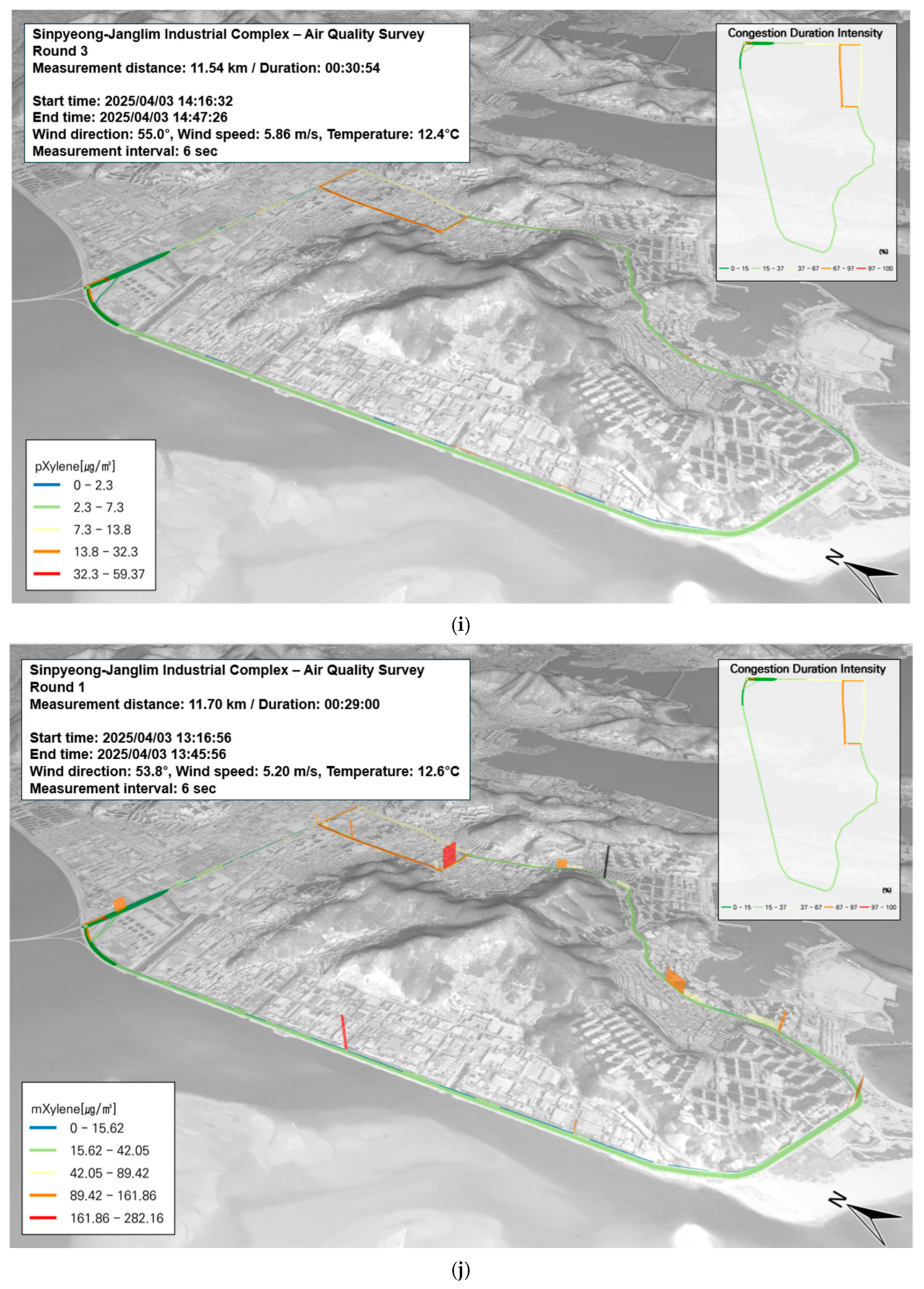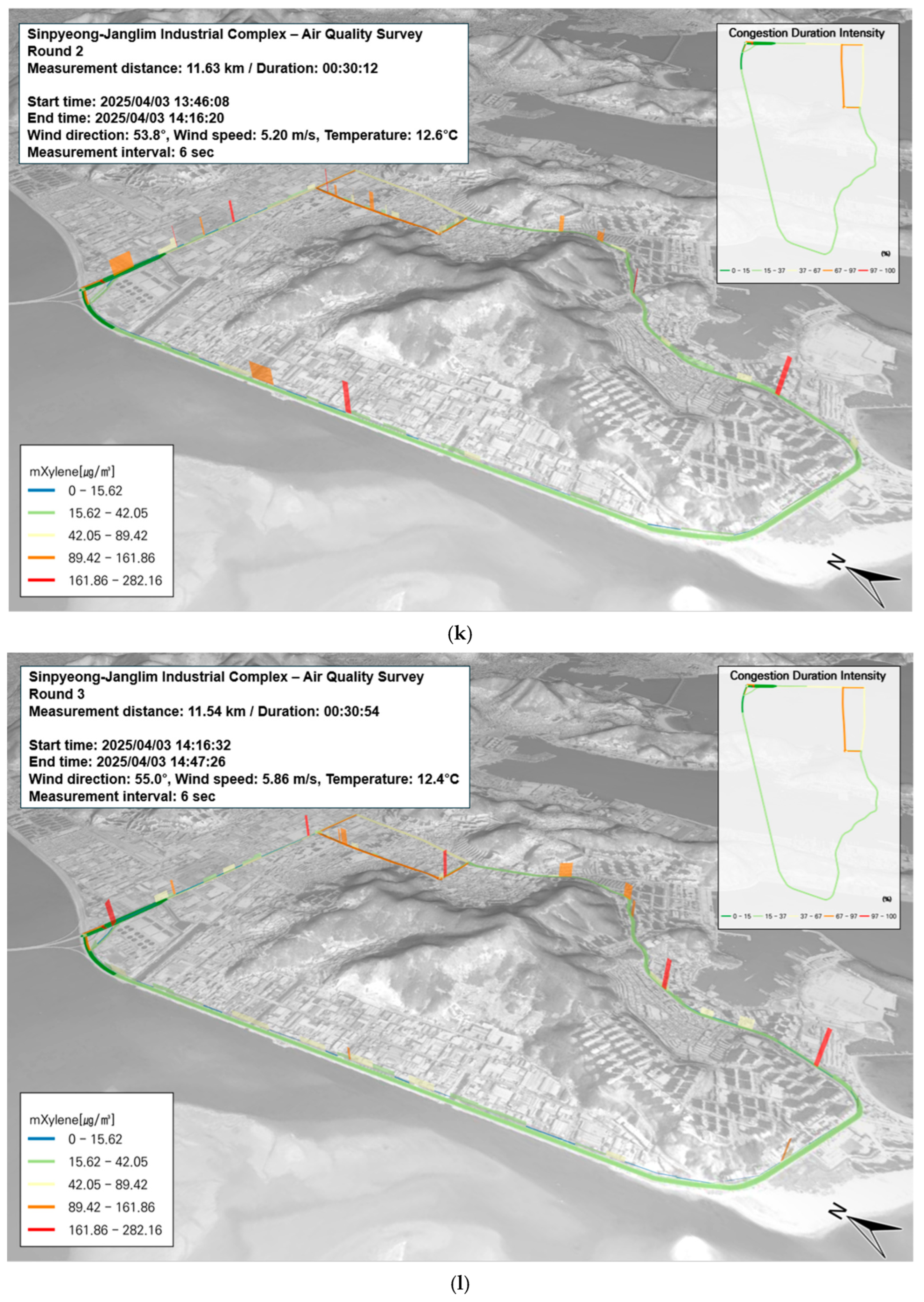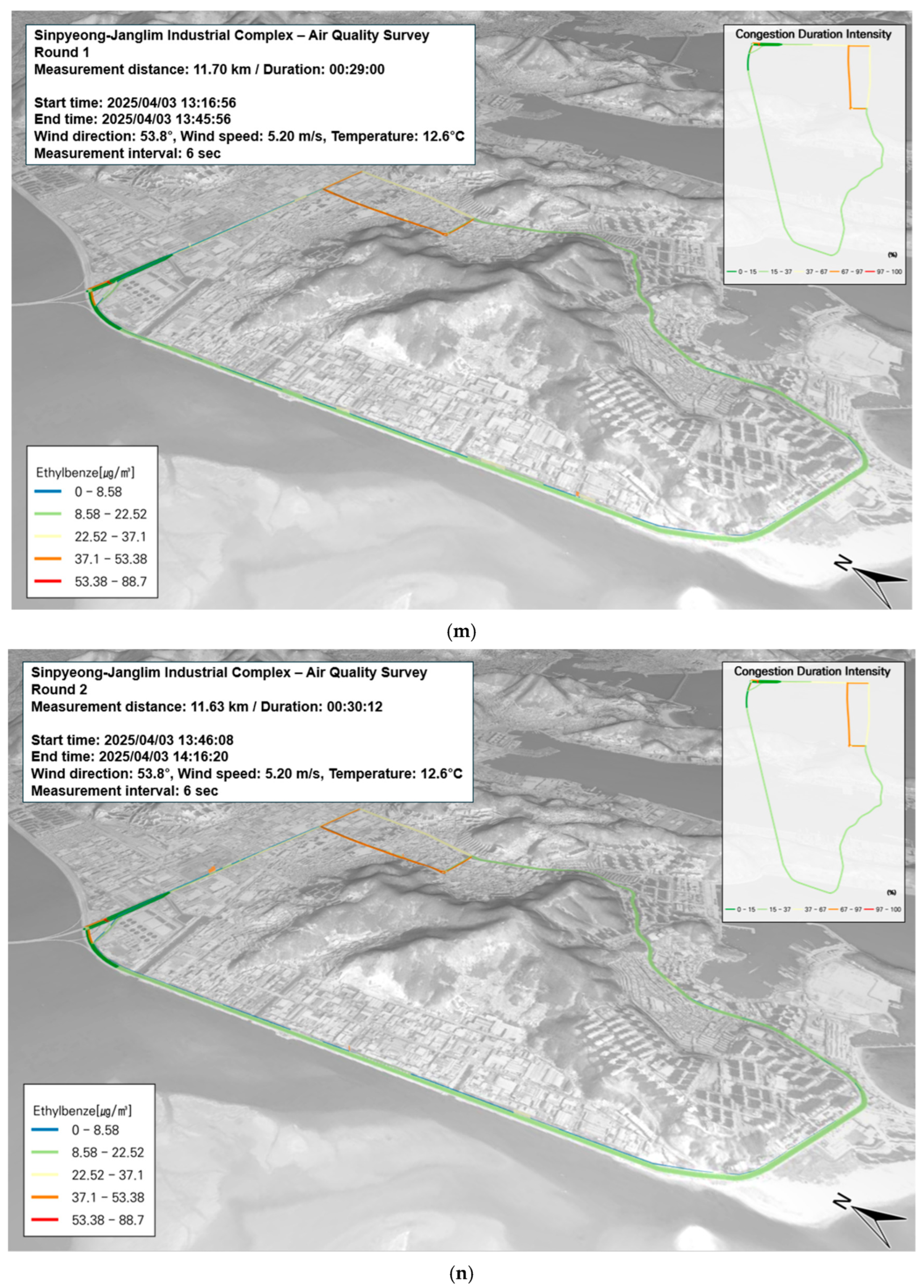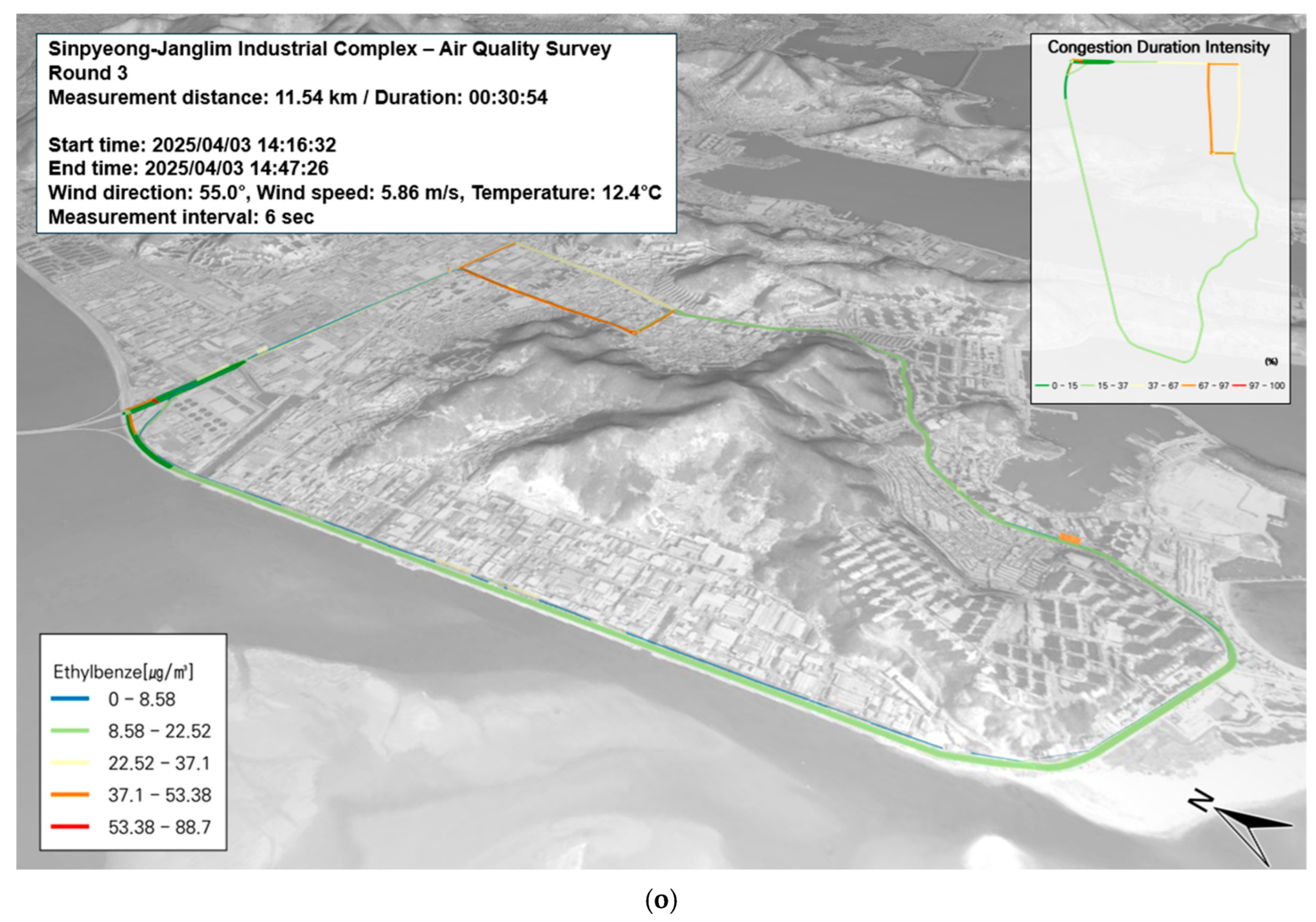1. Introduction
South Korea has rapidly industrialized over the past few decades, resulting in the development of 1330 industrial complexes as of 2024, including 53 national complexes and numerous general, urban high-tech, and agro-industrial zones, which collectively employ about 2.37 million workers [
1]. Due to the country’s limited land availability, residential developments have increasingly been situated adjacent to industrial zones, intensifying concerns over environmental pollution and health risks [
2,
3]. Although public awareness of particulate matter (PM) and offensive odors has increased, hazardous air pollutants (HAPs)—particularly volatile organic compounds (VOCs)—remain relatively under-recognized, despite their significant health impacts. Exposure to VOCs has been associated with respiratory diseases, neurological damage, and reproductive disorders, and VOCs also contribute to the formation of secondary pollutants such as ozone and PM through atmospheric chemical reactions [
3,
4,
5]. The Korean Clean Air Conservation Act currently designates 35 HAPs, including benzene and ethylbenzene, as controlled substances; however, air quality standards for many other compounds have not yet been established [
6,
7].
In 2022, Korea’s total emissions included 59,459 tons of PM
2.5 and 938,341 tons of VOCs, with the latter primarily originating from solvent use (54.9%) and industrial processes (15.5%) [
8]. While emissions have generally decreased since 2016 due to regulatory improvements and cleaner technologies, the detailed real-time monitoring of VOCs remains limited, especially at the facility level [
9]. Most existing studies rely on fixed monitoring stations, which fail to adequately capture the dynamic and spatial variability of airborne pollutants influenced by traffic patterns, meteorology, and land use. Previous studies in Busan have examined pollutant levels in industrial areas [
10,
11,
12,
13,
14,
15,
16,
17,
18], but most relied on fixed monitoring stations or data from local authorities. These stationary methods are limited in capturing the spatiotemporal variability of pollutants influenced by factors such as wind and traffic. Although mobile measurements help to address these limitations, they also face challenges such as short campaign durations, potential measurement bias due to vehicle motion, and difficulty in correcting background concentrations or identifying specific sources. Nonetheless, GIS-based visualization techniques can mitigate some of these issues through the integration of environmental and anthropogenic variables to map pollutant influence spatially. Recent research has increasingly adopted mobile monitoring to study VOC distributions over time and space [
19,
20,
21,
22,
23,
24,
25,
26]. This study differs in that it applies mobile measurements and GIS-based 3D spatial analysis, incorporating not only VOC concentrations but also contextual variables such as traffic volume. Traditional VOC analysis methods—such as adsorbent tubes, Tedlar bags, and GC–MS or HPLC—suffer from time delays and limited temporal resolution. In contrast, real-time techniques such as proton transfer reaction mass spectrometry (PTR-MS) and selective ion flow tube mass spectrometry (SIFT-MS) offer high temporal resolution and the ability to detect VOCs at ppb levels [
7,
27,
28]. Among these, SIFT-MS enables direct, real-time quantification of trace gases without the need for pre-concentration. However, SIFT-MS still faces limitations, such as high background signal, sensitivity to water vapor, and challenges in distinguishing isomeric compounds, which necessitate careful calibration and strict quality control procedures [
29]. Compared to these techniques, Me-DOAS offers a different approach based on optical remote sensing, providing integrated path-averaged concentrations over large distances without direct sampling. While its sensitivity may be lower than SIFT-MS in detecting specific low-concentration compounds, Me-DOAS has clear advantages in spatial coverage, robustness for mobile deployment, and suitability for atmospheric plume characterization.
To address these challenges, this study used mobile extractive differential optical absorption spectroscopy (Me-DOAS) mounted on a solar occultation flux (SOF) vehicle [
30]. Me-DOAS enables real-time VOC detection using ultraviolet light without pretreatment and, when combined with meteorological sensors, allows for comprehensive spatiotemporal analyses. Though Me-DOAS is sensitive to low absorbance and background variation, these are managed through stabilization procedures, reference point selection, and signal-to-noise evaluation to ensure data reliability.
Accordingly, this study aims to quantify the spatiotemporal distribution patterns of VOC emissions in industrial complexes by integrating real-time mobile monitoring data with three-dimensional GIS-based spatial analysis. Specifically, the study seeks to identify high-concentration zones, evaluate correlations with traffic and land-use factors, and delineate emission patterns over time and space. Focusing on two representative industrial areas in Busan—Sasang, with high traffic congestion, and Sinpyeong–Janglim, with comparatively lower traffic intensity—this study investigates how variations in traffic volume influence ambient VOC concentrations under similar regional and environmental conditions. Particular attention is given to the spatial and temporal distribution of emissions, the role of traffic-related activity, and the interaction with meteorological and geographic variables, such as wind direction and site layout. This study hypothesizes that traffic density serves as a significant modulating factor of ambient VOC concentrations, even within industrial zones exhibiting comparable emission profiles. It further posits that the observed spatiotemporal variability in VOC levels arises from the interplay among traffic-related emissions, localized industrial discharge characteristics, atmospheric dispersion dynamics, and temporal fluctuations in emission activity. By employing mobile extractive differential optical absorption spectroscopy (Me-DOAS) mounted on a solar occultation flux (SOF) vehicle and combining the resulting data with contextual environmental parameters, this study seeks to establish a robust, data-driven framework for air quality management in complex industrial environments.
3. Results
3.1. Concentration Distribution of PM and VOCs
The measurements were conducted in spring. On 2 April, the average temperature was 10.6 °C, with a wind speed of 1.9 m/s. On 3 April, the temperature was 10.1 °C, and wind speeds exceeded 5 m/s. The SOF vehicle measurement routes in both the Sasang and Saha Industrial Complexes passed through mixed residential and industrial areas.
Table 3 summarizes the average pollutant concentrations measured during the mobile runs, and
Table 4 presents the time-specific average values. Measurements were conducted during both morning and afternoon sessions on 2 and 3 April. However, only the stabilized afternoon values were used for analysis and interpretation. The sample size (N) for PM
10 and PM
2.5 measurements was 2675 on 2 April and 1233 on 3 April. For BTEX compounds, a total of 2201 data points were collected on 2 April, and 3304 were collected on 3 April.
On 2 April, the daily average PM concentrations from the Hakjang-dong monitoring station (near Sasang) were 27 µg/m3 for PM10 and 14 µg/m3 for PM2.5. On 3 April, the Janglim-dong station (near Saha) recorded 22 µg/m3 for PM10 and 11 µg/m3 for PM2.5. The mobile measurements for Sasang were consistent with the stationary station data, whereas the measurements for Saha were slightly higher than the daily average. PM10 and PM2.5 concentrations were not particularly high at either site.
Among VOCs, BTEX compounds were dominant. In Sasang, the BTEX composition was as follows: m-xylene (45.9%), ethylbenzene (31.7%), and toluene (17.9%). In Saha, the distribution was as follows: m-xylene (40.4%), toluene (25.5%), and ethylbenzene (12.7%).
The afternoon concentrations reflect localized factors. In Sasang, heavy traffic congestion and ongoing underground construction contributed to consistent emissions throughout the day, and this was unrelated to commuting hours. In contrast, traffic congestion in the Saha complex had a minimal impact on BTEX concentrations. BTEX compound dominance exhibited the following pattern: Sasang: m-xylene > ethylbenzene > toluene; Saha: m-xylene > toluene > ethylbenzene.
Control comparisons were made using nearby reference areas: Macdo Park (Sasang) and Dadae Riverside Park (Saha). In Sasang, benzene was half the level found in the target area, whereas toluene was 1.8 times higher, likely due to the prevailing wind direction (e.g., benzene: 0.9 µg/m3; toluene: 22.9 µg/m3; p-xylene: 5.0 µg/m3; m-xylene: 0 µg/m3; ethylbenzene: 0 µg/m3). In Saha, the control area exhibited generally low concentrations (e.g., benzene: 0 µg/m3; toluene: 11.1 µg/m3; p-xylene: 8.7 µg/m3; m-xylene: 14.2 µg/m3; ethylbenzene: 0 µg/m3).
Despite seasonal differences and temporal gaps, xylene and toluene were consistently detected at high levels in Sasang, likely due to the ongoing operations of small-scale facilities. Likewise, in Saha, BTEX concentrations (benzene, ethylbenzene, toluene, and xylene) were in line with past studies. However, unlike this study, previous research did not incorporate mobile emission sources or spatial variables and therefore could not identify spatial hotspots or location-specific influences.
3.2. The Correlation Between Pollutants and Traffic Congestion
Prior to performing Pearson correlation analysis, the normality of each variable distribution was assessed using the Shapiro–Wilk test and visual inspection through Q-Q plots. Most variables exhibited near-normal distribution patterns, validating the use of parametric correlation analysis. For variables that deviated slightly from normality (p < 0.05), the robustness of Pearson’s method was considered acceptable due to the sufficiently large number of observations and the exploratory nature of the analysis. Correlation coefficients were interpreted based on conventional thresholds (weak: |r| < 0.3; moderate: 0.3 ≤ |r| < 0.7; strong: |r| ≥ 0.7), and their significance was evaluated at the 95% confidence level.
Based on the collected data, the correlation analysis of the Sasang Industrial Complex revealed a strong relationship between PM
10 and PM
2.5 (r = 0.848). Among the pollutants, toluene exhibited a positive correlation (r = 0.175) with the duration of traffic congestion, indicating its association with traffic-related emissions. In contrast, benzene, xylenes, and ethylbenzene showed weak or negative correlations with traffic congestion, implying the involvement of different emission sources. Notably, m-xylene and benzene demonstrated a high correlation (r = 0.650), suggesting a potential common origin. These findings indicate that VOCs in the Sasang Industrial Complex may originate from a variety of sources, including industrial activities beyond traffic emissions (
Table 5).
The correlation analysis of the Saha Sinpyeong–Janglim Industrial Complex revealed a strong relationship between PM
10 and PM
2.5 (r = 0.894), which may reflect influences from common emission sources such as industrial combustion or vehicular activity. However, it is important to note that such correlations can also be affected by atmospheric processes, including differences in chemical reactivity, dilution rates, and secondary aerosol formation. Toluene showed a weak positive correlation with traffic congestion (r = 0.125), while other BTEX components generally exhibited weak negative correlations. Notably, p-xylene and toluene (r = 0.442), as well as benzene and m-xylene (r = 0.483), showed moderate to strong correlations, suggesting the possibility of common emission sources. Ethylbenzene exhibited negative correlations with most variables, indicating distinct emission characteristics. These results suggest that the BTEX concentrations in this area may be more influenced by industrial activities than by traffic-related emissions (
Table 6).
3.3. Spatiotemporal Patterns and Pollution Hotspot Analysis of PM and VOC Concentrations in Sasang Industrial Complex
In this study, concentrations of PM and VOCs in the Sasang Industrial Complex were measured along the SOF vehicle’s route and visualized as a three-dimensional (3D) spatial map using GIS. The GRIMM equipment was mounted on the SOF vehicle, with the inlet positioned at the top to sample ambient air. GPS data were integrated with pollutant concentration data to produce spatial visualizations.
This study utilized GIS to derive results that reflect spatiotemporal characteristics according to the time of day. PM
10 and PM
2.5 were recorded at 6 s intervals. Given that fine particulate matter is strongly associated with road traffic, traffic congestion levels along the measurement route were compared with PM levels to identify pollution hotspots. No significant hotspots were observed for PM
2.5. However, PM
10 concentrations were notably higher in areas with severe traffic congestion, as illustrated in
Figure 3c. This elevated PM
10 level is believed to result from ongoing underground construction beneath the roadway. Ventilation openings installed at the center of the road likely allowed pollutants generated from both above-ground and underground activities to escape and contribute to the local PM
10 concentration.
In this study, benzene was selected as a representative compound among BTEX species for targeted analysis. According to the current air quality standard, the annual average concentration limit for benzene is 1.5 ppb. Benzene is a highly volatile compound that disperses rapidly in the atmosphere and is primarily absorbed through inhalation. As a known carcinogen, benzene exposure at high concentrations has been linked to hematologic malignancies, including leukemia. Short-term exposure can affect the central nervous system, causing symptoms such as dizziness, headache, confusion, loss of consciousness, and irritation of the eyes and skin. Long-term exposure may result in anemia by reducing both white and red blood cell counts and impairing immune function [
19]. During the measurement period, the highest observed benzene concentration was 25.38 µg/m
3, and this was recorded in the Sasang Industrial Complex. The average concentration across the site was 1.8 ± 2.7 µg/m
3. No distinct benzene hotspots were detected along the entire route. When the benzene distribution was compared with traffic congestion data, no strong spatial correlation was observed. In fact, areas with high traffic volumes did not coincide with areas of elevated benzene concentrations (
Figure 4a,b).
In this study, toluene—which accounted for 17.9% of the total BTEX composition among VOCs—was analyzed as a representative compound emitted from anthropogenic sources. Toluene readily reacts with photochemically generated hydroxyl (OH) radicals and degrades in the atmosphere. Its concentration increases in the presence of vehicle exhaust and is significantly elevated in areas where toluene is directly used, such as in industrial processes and solvent treatment [
19]. In particular, high toluene concentrations were observed in zones heavily influenced by vehicle emissions. The average concentration measured in the Sasang Industrial Complex was 12.0 ± 35.8 µg/m
3, with a maximum value of 380.26 µg/m
3. As shown in
Figure 4c,d, elevated concentrations were typically associated with areas of severe traffic congestion. In some locations where extremely high toluene levels were recorded, a vehicle maintenance shop was situated nearby. This suggests potential exposure from various oils and waste substances used in automotive servicing. In addition, two gas stations and one hydrogen charging station were located in close proximity to the high-concentration zones. These facilities are likely contributors to the observed toluene levels due to the release of volatile pollutants.
In the Sasang Industrial Complex, p-xylene accounted for 1.7% of the total BTEX composition among VOCs, indicating a relatively minor contribution. p-Xylene is commonly used as a raw material in the production of PET bottles and snack packaging. The average concentration of p-xylene measured in the study area was 1.2 ± 3.1 µg/m
3, with a maximum observed value of 29.55 µg/m
3. As illustrated in
Figure 4e,f, although the section exhibited significant traffic congestion, no areas showed notably elevated p-xylene concentrations. Therefore, the correlation between traffic volume and p-xylene concentration appears to be weak.
In the Sasang Industrial Complex, m-xylene accounted for the highest proportion of BTEX compounds among the VOCs, comprising 45.9% of the total. According to the Ministry of Environment, xylene is widely used as a raw material in the production of basic chemicals and has a relatively high emission rate compared to other VOCs. Xylene is emitted not only from industrial facilities but also from construction sites using paints and adhesives and from vehicle exhaust, as it is a constituent of gasoline. The average m-xylene concentration measured in the study area was 30.7 ± 32.2 µg/m
3, with a peak value of 230.93 µg/m
3. As illustrated in
Figure 4g,h, elevated concentrations were detected in areas with heavy traffic congestion and in zones where industrial facilities are concentrated. In particular, high m-xylene levels were observed near the Sasang Machinery Processing Complex, which houses small-scale operations involving hydraulic machinery, cylinder assembly, and metal polishing, suggesting these activities as likely emission sources. Additionally, nearby metal manufacturing and steel foundry plants located close to the roadside may contribute to emissions. A gas station also situated along the route likely adds to the overall m-xylene pollution burden in this area.
In the Sasang Industrial Complex, ethylbenzene accounted for 31.7% of the total BTEX concentration among VOCs. Ethylbenzene is commonly used as a solvent in the production of synthetic rubber, paints, adhesives, pesticides, and automobile fuels. At elevated concentrations, it can cause dizziness, and irritation in the eyes and the respiratory tract can occur. The average ethylbenzene concentration measured in the study area was 21.2 ± 18.3 µg/m
3, with a maximum value of 122.04 µg/m
3. As illustrated in
Figure 4i,j, high concentrations were observed not only in zones with severe traffic congestion but also in areas where business establishments are densely clustered. Further analysis of the spatial distribution revealed that high ethylbenzene concentrations were often associated with metal manufacturing facilities—where metal cutting is actively performed—and with roadside steel foundries. In addition, several gas stations were located along the roadside, likely contributing to the elevated ethylbenzene levels.
3.4. Spatiotemporal Patterns and Pollution Hotspot Analysis of PM and VOC Concentrations in Saha Sinpyeong–Janglim Industrial Complex
In this study, the results of mobile measurements in the Saha Sinpyeong–Janglim Industrial Complex were visualized using a 3D GIS-based map. The GRIMM equipment was mounted on the SOF vehicle, with the sampling inlet positioned on the roof to ensure optimal air intake. Measurement data were synchronized with GPS coordinates and integrated into the GIS for spatial analysis.
This study utilized GIS to derive results that reflect spatiotemporal characteristics according to time of day. In addition to the overall correlation analysis, we also examined the spatial and temporal patterns by mapping the data for each time period and location. PM
10 and PM
2.5 concentrations were recorded at 6 s intervals. Given the known correlation between fine particulate matter and road traffic, the level of congestion along the measurement path was analyzed to identify pollution hotspots. Although the overall traffic volume in the area was low, elevated PM concentrations were observed in certain segments, particularly those illustrated in
Figure 5c,e,f. These areas were characterized by a high density of manufacturing facilities, including machinery and equipment plants, that were located immediately adjacent to the roadside. It is presumed that the elevated concentrations result from a combination of emissions from industrial activity and roadside vehicle operations, including gas station usage.
In the Saha Sinpyeong–Janglim Industrial Complex, benzene was selected as the representative BTEX compound for evaluation. The current air quality standard for benzene is set at an annual average of 1.5 ppb. Among all study areas, the highest benzene concentration was observed in the Sasang Industrial Complex during the measurement period, with a peak value of 39.75 µg/m
3 and an average of 7.3 ± 5.9 µg/m
3. In contrast, throughout the three measurement runs conducted in the Saha Sinpyeong–Janglim Complex, no locations exhibited relatively elevated concentrations. As shown in
Figure 6a–c, benzene levels in this area appeared to be unrelated to road traffic congestion.
In the Saha Sinpyeong–Janglim Industrial Complex, toluene accounted for 25.5% of the total BTEX concentration among VOCs and was analyzed as a representative pollutant emitted from anthropogenic sources. The average toluene concentration measured in the study area was 15.6 ± 31.6 µg/m
3, with a maximum value of 597.01 µg/m
3. As shown in
Figure 6d–f, the overall traffic congestion in the area was low. However, elevated toluene concentrations were observed in zones where machinery and equipment manufacturing facilities were densely clustered along the roadside. These concentrations are likely attributed to emissions from workplace processes, such as machinery fabrication and metal processing, rather than from vehicle traffic.
In the Saha Sinpyeong–Janglim Industrial Complex, p-xylene accounted for 9.4% of the total BTEX concentration among VOCs, indicating a relatively minor contribution. p-Xylene is commonly used as a raw material in the production of PET bottles and snack packaging. The average concentration of p-xylene measured in the study area was 5.7 ± 6.6 µg/m
3, with a maximum observed value of 111.11 µg/m
3. As shown in
Figure 6g–i, the area exhibited low traffic congestion, and no segments showed relatively elevated p-xylene concentrations.
In the Saha Sinpyeong–Janglim Industrial Complex, m-xylene accounted for the highest proportion of BTEX among VOCs at 40.4%. According to the Ministry of Environment, xylene is widely used as a raw material for basic chemicals, and its emission levels tend to be higher than those of other VOCs. The average m-xylene concentration measured in the study area was 24.7 ± 42.1 µg/m
3, with a maximum value of 295.97 µg/m
3. As shown in
Figure 6j–l, the area exhibited overall low traffic congestion. However, localized high concentrations were observed near areas with dense clusters of machinery manufacturing and processing facilities located adjacent to the roadside. These elevated levels are likely attributed to emissions from industrial activities rather than traffic. In particular, vehicle maintenance shops and textile manufacturing businesses located along the roadside appear to be significant contributors to m-xylene emissions in this area.
In the Saha Sinpyeong–Janglim Industrial Complex, ethylbenzene accounted for 12.7% of the total BTEX concentration among VOCs. Ethylbenzene is commonly used as a solvent in the production of synthetic rubber, paints, adhesives, pesticides, and automobile fuels. The average concentration measured in the study area was 7.8 ± 11.8 µg/m
3, with a maximum value of 61.0 µg/m
3. As shown in
Figure 6m–o, the area exhibited generally low traffic congestion, and no specific locations exhibited relatively high ethylbenzene concentrations. These results suggest that the correlation between traffic volume and ethylbenzene levels in this area is low.
4. Discussion
There are approximately 1330 industrial complexes in Korea, many of which are located in close proximity to residential areas. As a result, environmental concerns such as odor dispersion, hazardous air pollutants (HAPs), and fine dust exposure frequently arise. Despite these risks, the availability of fixed air quality monitoring data within industrial zones remains limited, and public awareness of air toxics, such as volatile organic compounds (VOCs), is relatively low.
In this study, real-time mobile measurements were conducted in two representative industrial complexes in Busan—Sasang and Saha Sinpyeong–Janglim—to quantify BTEX compounds (benzene, toluene, ethylbenzene, and xylene) and particulate matter (PM10 and PM2.5) using Me-DOAS instruments mounted on a solar occultation flux (SOF) vehicle. Compared to traditional monitoring methods such as SIFT-MS and GC-MS/FID, which rely on fixed networks or offline sampling, Me-DOAS provides high-resolution, second-by-second VOC detection without sample pretreatment. This enables the spatial tracking of VOCs under varying environmental and traffic conditions.
Spatiotemporal distributions were analyzed by collecting mobile data along pre-defined routes traversing both residential and industrial areas. Data were synchronized with GPS and meteorological information, including wind direction and speed, and visualized using GIS-based 3D mapping. Although wind data were considered to interpret VOC patterns, this study did not include dispersion modeling or mixing height analysis. We acknowledge that these factors, along with temporal meteorological variability, may influence pollutant distributions and warrant consideration in future research. The survey was conducted during spring (April), when PM levels are typically elevated due to meteorological influences. This integrated approach allowed for the examination of relationships between VOC concentrations and variables such as traffic congestion, facility types, and spatial patterns. Although the mobile monitoring campaign was conducted over a limited period of two days in April—a season typically characterized by elevated PM concentrations due to meteorological factors—it may not fully represent long-term pollutant trends. However, unlike fixed monitoring stations, mobile measurements involve practical constraints such as vehicle and instrument rental, route scheduling, and real-time equipment operation. Despite these limitations, mobile monitoring offers valuable insights into spatial patterns and localized pollution hotspots, serving as a complementary tool to fixed monitoring networks. Future studies will aim to extend the monitoring duration across multiple seasons and integrate the results with conventional fixed-site monitoring data to enhance representativeness and temporal coverage.
In particular, with respect to the results of this study, the higher concentrations of xylene compared to benzene and toluene may be attributed to its widespread use in solvent-based industrial processes, such as painting, coating, and cleaning operations. Additionally, xylene’s lower volatility may lead to its accumulation under low-wind or stagnant conditions, resulting in elevated measured levels during mobile monitoring.
The correlation analysis showed a strong association between PM10 and PM2.5 at both sites (r = 0.848–0.894, p < 0.01), indicating the likelihood of shared emission sources. In the Sasang Industrial Complex, the correlation between toluene levels and traffic congestion was weak and statistically non-significant (r = 0.175, p > 0.05), suggesting a limited or incidental relationship. Elevated concentrations of toluene, m-xylene, and ethylbenzene were mainly detected near small-scale metal workshops, gas stations, and underground construction areas, pointing to localized emission sources. A significant correlation between benzene and m-xylene (r = 0.650, p < 0.01) suggests possible co-emission from common sources. In contrast, in the Saha Sinpyeong–Janglim area, p-xylene and toluene showed a moderate correlation (r = 0.442, p < 0.05). Overall, BTEX levels in this area appeared to be more strongly influenced by industrial land use and prevailing wind directions than by traffic activity. It is important to note, however, that confounding factors such as meteorological variability and temporal emission patterns may also have affected these relationships and should be considered in their interpretation.
While this study primarily examined the spatial patterns of VOC concentrations in relation to traffic and industrial activity, it is important to acknowledge the influence of meteorological and atmospheric chemical processes. Boundary layer dynamics, atmospheric stability, and air mass transport can significantly affect pollutant dispersion. Additionally, differences in VOC reactivity and atmospheric lifetime, particularly through reactions with hydroxyl radicals, play a critical role in determining their persistence and potential to form secondary pollutants. Future research should incorporate photochemical modeling and vertical mixing parameters to better elucidate the transformation and environmental behavior of VOCs in complex urban–industrial settings.
However, definitive source apportionment was beyond the scope of this study, as receptor modeling techniques, chemical tracers, or bivariate polar plots were not applied. Future research incorporating such methods would help to clarify the contributions of individual emission sources. GIS-based 3D visualization enabled the identification of VOC hotspots, improving interpretability over conventional 2D methods. By overlaying variables such as traffic data, facility type, pollutant concentrations, and meteorological conditions, this method supports more targeted air quality management strategies.
While Me-DOAS offers significant advantages in terms of real-time, high-resolution monitoring and ease of deployment, its limitations must also be acknowledged. Due to its optical path configuration, Me-DOAS can be sensitive to background signal noise, low SNRs (signal-to-noise ratios), and spectral overlaps—particularly for compounds such as toluene and xylene, which exhibit broad UV absorption features. To mitigate these issues, background correction was performed using low-concentration reference points, and outlier filtering procedures were applied. Benzene, with minimal spectral interference, proved to be most suitable for accurate detection. Despite these limitations, Me-DOAS remains a valuable tool for capturing dynamic VOC behavior in complex urban–industrial environments.
While the GIS-based 3D visualization effectively highlighted spatial emission patterns and localized VOC hotspots, we acknowledge that the choice of the interpolation method and the lack of semivariogram diagnostics may limit the ability to fully assess spatial uncertainty. Future work will incorporate formal interpolation algorithms such as Kriging or inverse distance weighting (IDW), along with semivariogram modeling, to improve the robustness of spatial analyses and uncertainty quantifications.
Additionally, we recognize that the use of 3D extrusions may visually exaggerate small concentration differences, potentially introducing perceptual bias. To address this, future visualizations will include normalization procedures or alternative cartographic techniques that more accurately reflect the underlying data distribution.
5. Conclusions
This study demonstrated the effectiveness of Me-DOAS-based mobile monitoring, integrated with GIS-based three-dimensional visualization, in characterizing the spatiotemporal distribution of VOCs in urban–industrial environments. By comparing two representative industrial complexes in Busan—Sasang, characterized by high traffic congestion, and Saha Sinpyeong–Janglim, with relatively lower traffic volume—we assessed the extent to which vehicular activity influences ambient VOC concentrations.
Correlation analysis indicated that the association between toluene levels and traffic congestion in Sasang was weak and statistically non-significant (r = 0.175, p > 0.05), suggesting that traffic alone is unlikely to be the predominant source. Instead, elevated concentrations of m-xylene and ethylbenzene were consistently observed near localized emission sources such as gas stations, underground construction sites, and small-scale metalworking facilities. In Saha, VOC levels were more closely linked to industrial zoning patterns and prevailing wind directions than to traffic activity. These findings imply that, although traffic may contribute to VOC variability, localized industrial operations and meteorological dispersion dynamics are more influential determinants of spatial concentration patterns.
Despite the temporal limitations of the monitoring campaign, the Me-DOAS system enabled high-resolution, real-time detection of BTEX compounds, with benzene yielding the most reliable results due to minimal spectral interference. The incorporation of GIS-based 3D visualization further enhanced spatial interpretability and enabled the identification of emission hotspots not captured by conventional fixed-site monitoring networks.
Overall, the study presents a scalable and data-driven framework for diagnosing local air pollution dynamics in complex industrial settings. Future research should prioritize multi-seasonal campaigns, integration of dispersion modeling and exposure assessment tools, and cross-validation with traditional monitoring methods to improve representativeness, reproducibility, and policy relevance.
